
 |
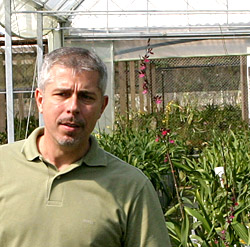 |
Roberto
Agnes is the grower, hybridizer and technical director of Aranda. Italian but born in London, England, he grew up in Cape Town, in South Africa, where he did his studies and lived until he was 24 years old when he fell in love with Rio de Janeiro city and decided to live there. One of the founders of OrquidaRio (the local orchid society in Rio de Janeiro) where he has been, successively, director of shows, of judgments, technical director, member of the Deliberative Council, editor of Orquidario magazine's and one of the responsibles for the introduction of the modern concepts in orchids judgment in Brazil. |
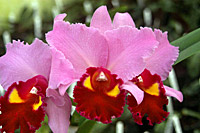 |
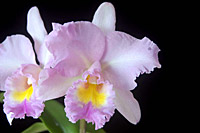 |
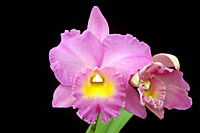 |
| ON: Roberto, why did you start to cultivate orchids? Which was the magic moment of attraction? |
RA:
I would say it was a love at first sight. I was eleven years old when I saw an orchid for the first time. It was in Cape Town, in South Africa, where I lived. In a school excursion, we got into the greenhouse of the Botanical Garden and I saw an exotic plant, I took a piece and put it in my haversack. When I got home, my parents gave me a scolding. The plant was an Epidendrum fragrans (Prosthechea fragrans). After researching and finding out that it comes from Brazil, I put it in a pot in a dark potting soil and watered it every two hours. Of course, the plant died within a week, it became a mass totally rotten. My parents told me to go the library and study and then try again. I started to read a lot and I was even forbidden to talk about orchids on the table because, I just talked about them. During the winter holidays, I worked at my father's industry in order to get an extra money for buying plants. I saw an announcement of a nursery selling Cymbidium back bulbs already sprouting and it cost, I would say, 2 dollars and I had 20. The owner allowed me to choose ten however he asked me to come back a month later when he would give me the plants. Full of joy, I waited and kept the money. When I came back, he had separated 10 small plants which weren't back bulbs and a Cymbidium with 120 flowers. I became confused, crazy, without knowing what to do, imagine, I just was 11 years old! My father bought the big plant, I bought the small ones and thus my collection started. Since I was a child, I always loved plants and in my grand-parents' house, I always helped in the garden. It is funny but when I lived in Cape Town, we were neighbors of Brazil's Embassy, my first orchid was Brazilian and I came to live here. |
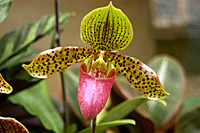 |
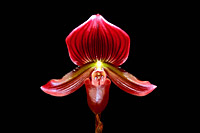 |
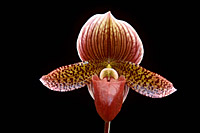 |
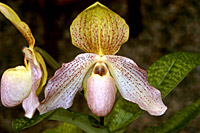 |
| ON: Besides that first attraction, was there any influence (people or fact) regarding your relationship with orchids? |
RA:
Some people. I like to tell about who has been my orchidophil godmother,
Frieda Duckitt. She gave me a great push. We got on very well with
each other, I helped her in nursery and got plants in exchange. |
|
ON:
You
didn't have many choices. How was your formation as a grower?
How long have you been cultivating orchids?
RA: Since 33 years ago. It is a good time, I've never stopped. From my first orchid until met Frieda, many years have passed, I would say that my formation came from my determination, I used to go very often to the libraries, I copy by hand everything concerning the cultivation and the species. I have a handy copy of Sanders. I also had a very severe formation in judgment in South Africa. |
ON:
Which is your favorite plant?
|
RA: The plant which is blooming in the moment. Seriously: Brazilian species which I loved; Paphios, no matter if it is species or a hybrid; I adore Phragmipedium, but I can't say that I like better one or another. In the last show, I did, for example, an entire "island", of Phragmipedium to pay homage to those South American plants. |
|
| ON: What plant do you have in your collection? Just Brazilian species? |
| RA:
Every one is fascinated for rare thing, but I have a quite peculiar
taste, I need a flower with "something", it can be in the
color or in the shape. I wouldn't like to define my collections as being
only Brazilian species or just Paphio or Cattleya. In my opinion,
all of them have a peculiarity, sometimes, people look and don't see
any interest in what I like. See Neolauchea pulchella alba (Isabelia
pulchella), with so delicate flower, I find it one of the most beautiful
things. |
|
| ON: But if you have to do a collection with just 10 plants? |
|
|
|
|||
|
RA:
Hard question. Some species, for sure, Phragmipedium, Paphiopedilum, Cattleyas I made (seeing those seedlings blooming for the first time, makes me very happy). It is hard, because there are some many beautiful flowers, recently, a Eriopsis biloba bloomed which let me astonished, I just knew it by photo. In the last years, I have been doing some hybrids of Phalaenopsis with good results. My collection is extremely eclectic. I would have a great difficulty to choose something. I have friends who just have Cattleya walkeriana in their collections, I find it terrific but I would be bored. |
|
|||
| ON: You have different conditions of cultivation, how is your collection distributed? |
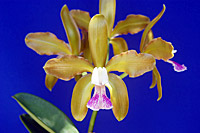 |
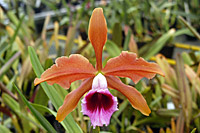 |
|
RA:
I have already made the mistake of putting many plants in just one space,
we finish for gathering plants which don't have the same cultural needs
and which are not from the same climate. Nowadays, I prefer to keep small niches in each greenhouse. I let, in the stating, small spaces where the plants are better adapted. In Aranda 1 (where started, in Teresópolis), we have one nursery for the collection where the hybrids of Cattleya are cultivated. We keep another one with the selected plants of Laelia tenebrosa or Cattleya walkeriana. The plants of Cattleya granulosa are in another warm greenhouse. Crossing the street, there is another greenhouse with the selected plants of Cattleya loddigesii, C. intermedia and Laelia purpurata. There, they bloom better as if they were in the nursery of the collection because it is too warm for those species. |
|
|
|
|
ON: Are you talking about Teresópolis? Do you mean that you cultivate Cattleya granulosa in the mountain? RA: No, in general, they are cultivated in Guapimirim because this species needs warmer temperatures. I keep two or three super-granulosas there, in warm greenhouse. So I keep the cultivation of those plants up and, every blooming, they are used for new crosses. The other selected Cattleya granulosa which I use for the shows stay in Guapi where it makes heat and they grow specially well. So, I prefer keep them in a place where the climatic conditions are adequate for this species. ON: Which are those conditions in Guapi? RA: The advantage of Guapi is the heat almost all year round. There, the Cattleyas, besides another species of warmer climate, react well, grow and bloom very well. The greenhouse are at the base of the mountain where there is a good ventilation which helps a lot in the cultivation of orchids. I take advantage of the two different climatic conditions thus gaining time in the cultivation. As soon as the plants leave the laboratory, in Teresópolis, I bring them to Gaupi. In this way, the seedlings grow quickly due to the heat. Even during the winter, it is rare the temperature to fall below of 14º C. The fall of nocturnal temperature, in the winter, is above of 10º and in the summer, it arrives close, it falls from 30 and few degrees to twenty and few degrees. This fall is beneficial for the plant. Of course we have a problem when the temperature, during the day, climbs to around 40, 42 degreesº and the nocturnal one stays around 25, 26º. Those high temperatures damage a little the development of the orchids, so we use the fans and spray water to refresh the greenhouses. ON: Do you Phalaenopsis in Guapi? RA: They were cultivated in Guapimirim. We put them in another area which is, at about, 150m higher than Guapi where the climate is a little mild. The plants react very well due to a series of factors. The greenhouses are in the middle of the mountain and are well ventilated for the breeze that goes down the mountain or through fans. The temperature is not so high as in Guapi and the fall is a little more accentuate, what it is very important for the budding of Phalaenopsis. I prefer that the inflorescence delays a little to strain itself, thus the flowers finish for lasting for more time. Peaks of temperature can harm the budding and to prevent loss of flowers we keep the fans functioning even during the night. Looking at the inflorescence, we can know exactly when it made much heat, therefore the buttons turn yellow and wither. In this place, I have other species that like heat which react well to a a bigger fall of temperature. ON: Teresópolis is more cold, do you cultivate Sophronitis hybrids and species such as Laelia purpurata, Cattleya loddigesii and Cattleya intermedia? Do you think that Laelia purpurata need cool condition? RA:
I wouldn't say a cool climate, it is temperate what is good for those
plants. You should remember that Laelia purpurata is found in
the state of Rio Grande do Sul, where is hot during the summer and sufficiently
cold in the winter. ON: What else do you cultivate there? Masdevallia, Cymbidium, Paphiopedilum? RA:
Teresópolis has the advantage of having a milder summer. The
winter is too cold for the Paphios with mottled leaves which are cultivated
in a warmer greenhouse. Those plants grow extremely well and give an
excellent bloom. In the summer show, we had a great number of them blooming
in a season where, in general, there are few flowers. With small adjustments,
we can got better results. It is much easier to heat a greenhouse then
to try to reduce the temperature. In the winter, in some nights, the
temperature falls into 3, 4, 5ºC, and this Paphios could not be
cultivated without heating. The other plants of temperate climate are
not affected by a temperature bellow 10º since it doesn't last
for a long time but the permanence intervenes with the metabolism of
the plant. |
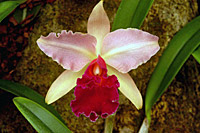 |
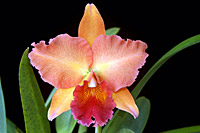 |
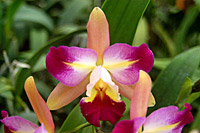 |
|
ON: Plastic or clay pot? RA: : I opted for plastic pot, it is a scale question since, in Guapi, we have, more or less, 250 thousands Cattleyas between adults and seedlings of different size. The plastic pot has many advantages, it is easier to sterilize for a new utilization is lightweight to carry, keeps more humid for longer time and our nurseries are covered. With clay pot, may be, we have to water every day during the summer, with the plastic one, we can water every two or three days, this represents an economy of water, time and energy. Moreover, as we export an amount of plants, the plastic vase allows to remove them clean and without damaging the roots. ON: So, during the summer, the rule is to water every three day in Teresópolis? RA: I don't like a routine pre established. This year is a good example, this summer has been having so mild temperature that we should to reduce the frequency of watering. In general, we water two or three times a week, but it is raining a lot and there is too much humidity in the air, we just water once a week. In general, the rule is water once a week during the winter and goes on increasing until two or three times a week during the summer. Of course, there are the exceptions such I have just mentioned and the plastic pot allows the reduction of water. When we start to cultivate orchids, we learnt that too much watering provokes the a more quick decomposition of the substrate and, as a result, the rotting of the roots. If you are in doubt, leave the watering for tomorrow. ON: With the prohibition of using the tree fern fibre, how are you solving this problem of substrate? RA: We are concerned about this, we are doing experiences using coconut fiber, with pebbles and bark, until now, it is doing well. ON: However, coconut fiber deteriorates too quick, doesn't it? RA: Yes, so you should be careful with your supplier, to know the origin and be sure about the treatment it receives for having the salts removing. One of the problem is that during the process of drying up, the fibers go through giants cylinders to get out the water and, if the fiber is too much pressed, it suffers a rupture and finishes for deteriorating too much quickly. It must be spongy. For the present, the plants are reacting well, the roots grow quickly however, it is just too years of experience. It is not time enough to know what will be the result a long-term. We should to be adapted the proportions, for seedling, I use a little quantity of fibre because it retains a little more the water and smaller pieces of bark. There are many graduations of the bark, for adult plants, bigger pieces. In the case of Paphio, I used more small pebbles and bark than fiber. With Cymbidium, for example, there are much more pebbles, with the rupicolous, there is very little fiber, the substrate is almost done by pebbles and bark. So for each kind of orchid, there is a mix slightly different which I go on adapting. In general, our substrate is composed by 1/3 of pebbles, 1/3 of coconut fiber and 1/3 of bark. Meanwhile, we don't have many choices, that is what we have. We are very luck to live in a country where there are so many habitats and so close, this allow us try to adapt the best way possible the cultivation of our plants. When you see a rupicolous plant growing in its habitats, you realize that those plants need to be cultivated in small clay pots with a substrate which dries out the most quickly possible. |
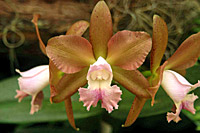 |
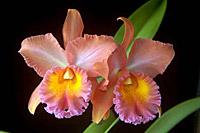 |
ON: Do you have a cultivation tip to share with us? RA:
Cultivation tips, anybody has! I would say that that we should pay attention
to the needs of each plant. Many times, a plant doesn't grow well in
a corner of the green house but does better if put in another one with
little different conditions. It is amazed that small infestations are
not aware. I see it in our greenhouses, some small focus of infestation
appear suddenly and, if not see in time, they damn the plants. I can
have thousand health plants in the greenhouse, invariably, I will find
out the only one which has a small focus. I think it is important to
able to see those small problems. Some times, I stay surprised seeing
someone passing near to a plant and don't realized that there was something
wrong. I don't like to see damaged. |
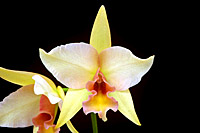 |
| ON: One said that orchidophilia a soft manifestation of madness. Have you done any "orchidophilic" insanity? RA: I still go on doing. Sometimes, I can't say how much I paid for a plant. It can be because it is rare, a passion for this flower to beautiful or, sometimes, we see the great potential as a matrix. Of course, when we are with another professional, we both have the notion of the plant value. I don't think it is a crazy thing, it is passion, it is the compulsion of the collector. Nowadays, I control a little better my self for not buying something and in the next second, be sorry for having buying it. Nowadays, I stop before doing a madness and analyze for knowing if it is worth or not. |
|
ON: Is there an amusing story connected to orchids you can tell us? RA: For sure, it is one of the most stupid thing I did. In my first excursion to Serra dos Órgãos (mountainous region), I climb a tree to photograph a wonderful clump of Sophronitis. When I looked down, I realized that I was in a branch (not too much strong) and there was a drop of, at least, 300m. I was awfully frightened, I stayed paralyzed, I couldn't move afraid of falling down. All people in the group knew about that but they didn't say any thing, they burst out laughing. It was a pretty foolish thing that, at least, was worth while for a good photo. |
| ON: Thank you , Roberto Agnes. |
| Photos: Roberto Agnes (all) except for Roberto's image and Phalaenopsis which are by ©Sergio Araujo |
| Identification
of the orchids (from the to bottom, from the left to right): Blc. Samba Coral Blc. Samba Opera Blc. Samba Parfait Paph. Graham Robertson Paph. (Red Glory x Pacific Magic) Paph. (Schaetzen 'Bronzine' x Macabre) Paph. (welleslianum x moquettianum) Miltonia spectabilis var. moreliana Paph. (Mistic Jewel x Hasta la Vista) Galeandra chapadensis Aspasia silvana Cat. warneri 'Samba Perfection' Dyackea hendersoniana Phrag. Hanne Popow Cat. leopoldii 'Samba Tiger" Phalaenopsis Cat. granulosa Laelia tenebrosa Cat. intermedia Cat. loddigesii Laelia purpurata Potinara Samba Amigo Blc. Exotic Apricot Blc. Shiniti Isikawa Blc. Peach Cobbler Blc. (Eve Marie Barnett x Goldenzelle) Slc. Coastal Sunrise 'Sunshine' Sophronitis Arizona |
| Any
kind of reproduction (print, digital or anyone) of any type of material
of this site: texts, layout, photos, images and others - is strictly
forbidden without previous written permission of the authors. Any solicitation
or information should be done by the e-mail:
bo@sergioaraujo.com |